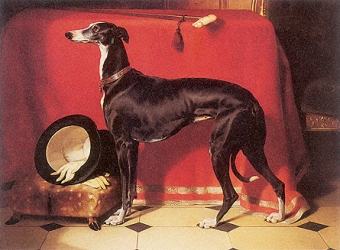PANCREATITIS

EEEos, a
Favourite Greyhound, the Property of H.R.H. Prince Albert;
Landseer,
Sir Edwin Henry (1802-1873); 1841
Image courtesy PicturesNOW!.
Suzanne Stack, DVM
Pancreatitis is an inflammatory
disease of the pancreas. The pancreas is a finger-sized, spongy,
flesh-colored gland that sits beside the small intestine in the
abdomen. Its job is to manufacture and secrete digestive enzymes
and insulin. When stimulated by the animal swallowing food,
digestive enzymes are released into the small intestine. Think of
pancreatitis as the pancreas trying to digest itself. Pancreatic
tissue damaged by autodigestion can become infected and even
necrotic (dead).
Pancreatitis is no more peculiar to
greyhounds than to any other breed. In fact, the poster dog for
pancreatitis is the miniature schnauzer due to its high incidence
of hyperlipidemia - a condition of inordinate amounts of fat in
the blood - "doggie high cholesterol," if you will. Not
surprisingly, the schnauzer also has an increased incidence of
diabetes, caused by a dysfunctional pancreas that doesn't make
enough insulin.
Some cases of pancreatitis have no
cause that can be readily identified. An equal number can be
directly traced to the dog consuming greasy or fatty food.
Sometimes it's a whole tub of butter, other times, a single scrap
of steak. Nobody really knows why you can add a little bacon
grease to a dog's food regularly and then one day - BAM! -
pancreatitis. Don't take the chance.
Pancreatic infection is more dangerous
than infection within the gastrointestinal tube (stomach,
intestines) because the pancreas sits free in the abdomen.
Surrounding organs may become contaminated, resulting in
peritonitis (infection of the entire abdominal cavity), which has
a high mortality rate. Pancreatitis can lead to kidney failure and
DIC, an endstage bleeding disorder triggered by a variety of
conditions from parvo to heatstroke. DIC stands for disseminated
intravascular coagulation - a.k.a. Death Is Coming, Dead In Cage,
Dog In Cooler, etc.
Signs of pancreatitis are loss of
appetite, lethargy, fever, vomiting, diarrhea, and a painful
abdomen. Not every dog has every sign. Cases vary from mild to
life threatening. In serious cases, the belly is tender to the
touch.
The classic case has milky appearing
serum due to the high amount of fat in the blood (lipemia). Other
lab findings are a high white blood count, high amylase and
lipase, and possibly a high BUN, liver enzymes, and / or glucose.
Electrolyte derangements are common as a result of prolonged
vomiting.
The cornerstone of treatment is to get
the dog off all oral intake (including water) to reduce pancreatic
stimulation. This necessitates intravenous fluids until vomiting
has stopped and the dog is able to keep down food and water again,
typically several days. Antibiotics and anti-vomit medicines are
usually needed.
Recovering pancreatitis dogs are
placed on a bland lowfat diet. Most can be weaned back to their
regular dog food, assuming it has a reasonable fat and protein
content. Severe cases are best kept on lowfat food forever. Any
dog that has suffered through a bout of pancreatitis should never
again be fed anything fatty or greasy in any amount as they are at
increased risk for recurrence.

©
Copyright 2015 GreytHealth.com. All rights reserved.
Website by
WagWorks